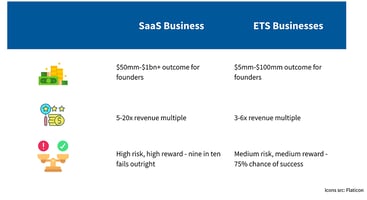A startup is an experiment to prove a product-market hypothesis. It is often stated that 90-99%...
How The Technology Adoption Curve Impacts ETS
When we introduced ETS we briefly touched on how the sales motion is different between ETS and traditional tech services here but we wanted to dive deeper in the topic. In order to understand the difference between them it is important to recognize how ETS sits on the boundary between product and services. Hence we have to understand some ideas from both those worlds. In particular understanding the chasms expressed by Geoffrey Moore in his book “Crossing The Chasm” and the spectrum of professional services companies as defined by Ashish Nanda and Das Narayandas in their HBR article.

How ETS Firms Navigate the Technology Adoption Curve
As in the name, Emerging Tech Services are centered around emerging technologies. Your customers and the platforms you work on with them will follow the chasms and the respective buyer profiles as identified by Geoffrey Moore. So you have to change your profile and strategy to match them. They will each play a role in the development of your company.
The innovators are the best target to experiment and learn from as you’re trying to understand what the new technology enables. In professional services terms you’ll be a rocket scientist practice. The downside of the innovators is that they are not the highest paying customers so you will not be able to thrive as a business on them. But in your early days they’ll not only be willing to take a risk on the hare-brained ideas you have to offer but also that a no name like you can deliver on these ideas. This is going to be your opportunity to learn, experiment, and figure out the value you can see so you can grab the attention of the early adopters. This is also the time to create credibility, partnerships, and alliances.
And while the innovators provide great learnings you need to be trying to win the early adopters. These are people that need a clear vision defined for them. They will be more demanding than the innovators and expect you to solve a business problem. Fortunately for you by experimenting on the innovators you are prepared to answer their questions. You have vetted out the limitations, become comfortable with the platforms, and know what is a reasonable promises to make. You can back that up with your experiential learning. But the work you do would still be a rocket science practice. While it is true that you would have worked on most of the individual components you still wouldn’t have the experience to bring it all together. Your sales work will require your to tie the business value to the technology and propose the solution architecture. This is where you start operationalizing and scaling yourself to turn into a gray hair practice. This includes generating customer references, case studies, and proof of accomplishments.
Finally you start entering the early majority. This is where you have to scale your operations. As an aside when you’re entering the early majority stage you should either start experimenting on your innovators with the next big thing or plan to exit. Because this is the most lucrative stage of being an ETS company and you want to make sure you don’t become yesterday’s news as the world of technology changes. Now this group will expect to see complete production ready implementations. Fortunately for you, you would have collected these resources through your reference architectures and production deployments. Fortunately for you being in services the chasm to bridge is smaller since you can provide the complex integrations necessary to achieve the desired outcome.
The ETS founder needs to recognize that they won’t be using the regular language of services companies. Their sales motions are going to be different and their company will see rapid shifts in their external environment. An ETS will not realize it as the market, and their ideal customer profile shifts. It is essential for an ETS founder to understand how these shifts will happen and adapt their organization to the changing reality that they operate under.



